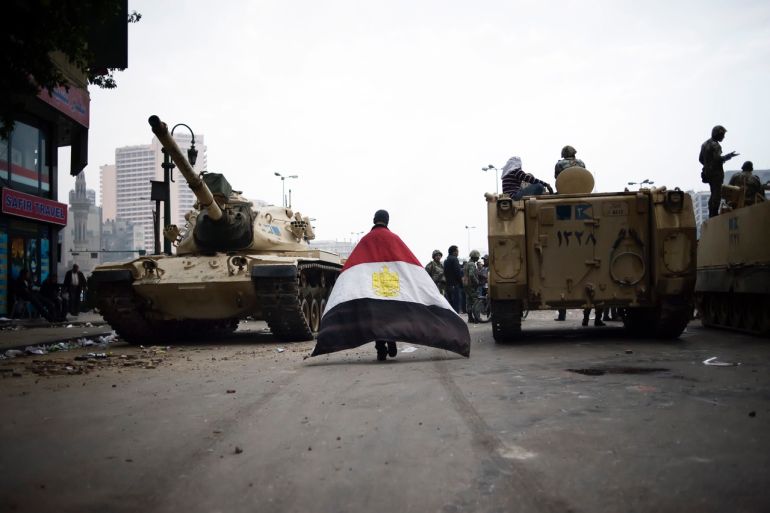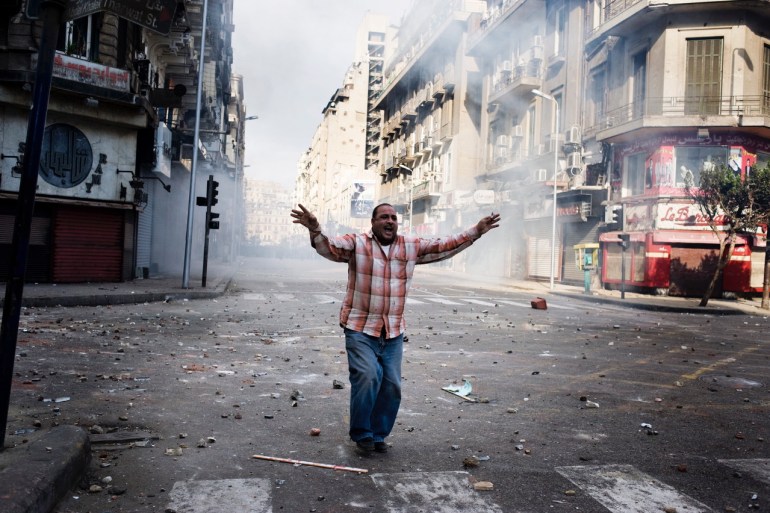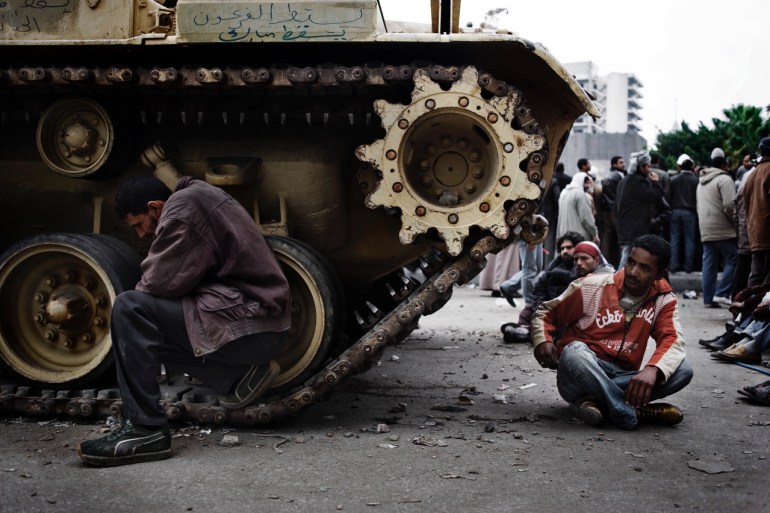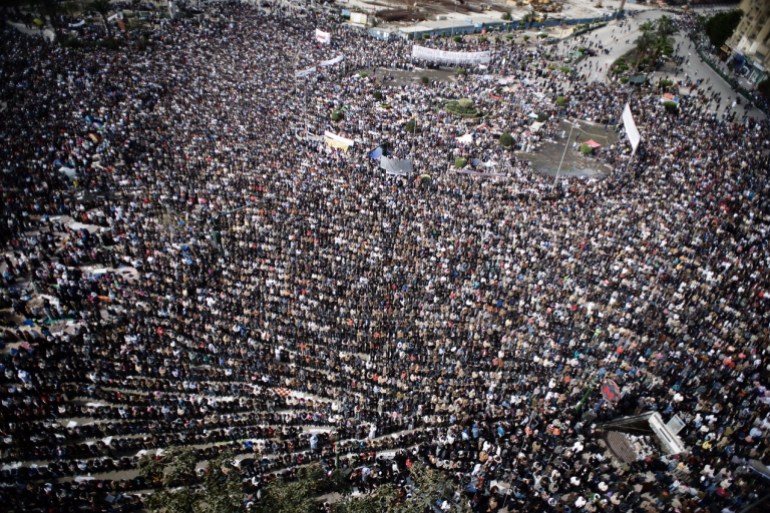Egypt 2011: ‘We did not know we would be documenting history’
A photojournalist who was in Tahrir Square at the start of Egypt’s uprising reflects on the day he knew a revolution had begun.

In December, 2010, anti-government protests erupted in Tunisia, soon triggering similar demonstrations across the Middle East and North Africa, including in Egypt, Libya, Yemen and Syria. Ten years on from the start of the Arab Spring, photographers who captured the first passionate moments reflect on what they saw and what the events of the time meant to them.
Alessio Romenzi is an award-winning photojournalist who covered the uprisings in countries including Libya and Syria. He was in Egypt’s Tahrir Square during the first week of protests in January and February 2011, which led to the ouster of then-President Hosni Mubarak after 18 days. He reflects on that time in the history of the country.
Keep reading
list of 4 itemsRemembering the Arab Spring: In films
Ten years after the Arab Spring
What is the Arab Spring, and how did it start?
When I arrived in Cairo in January 2011, I had no idea the days to come would be in the history books of the future.
It was the morning of the 28th – three days after the now-infamous January 25 protests began in Tahrir Square – when I landed in Cairo together with some colleagues. We had been reporting in Amman, Jordan, and from speaking to our contacts in Egypt, there was a sense something big was going to happen.
That day was the first Friday of protest. The weekly midday prayer had just ended and people began to leave the mosques, thousands marching, making their way to Tahrir Square. We joined one of these marches, the ground was strewn with stones and pieces of bricks. Around us, all the shops were shut, and as the crowd made its way down the street, at the far end, the police and SWAT were positioned, waiting to intercept protesters to prevent them from getting into the square. They knew people wanted to occupy the square. And the regime understood it was not a good advertisement if a huge crowd of protesters took a main square in the city.

The people were determined to get there. At the front of the march, I snapped a photo of a man who stepped to the front of the crowd of thousands trying to calm them. “Shway, Shway” (slow down) he said, assuring them that they would eventually reach the square. With the police a few hundred metres behind him, he did not want violence and was trying to avoid a serious clash. He asked them to stop throwing stones, to not agitate the police who were firing tear gas.
Being in the middle of that, there was a mix of excitement, but also apprehension. You feel like you are in the perfect place to capture the historic event, but there is a certain sense of fear because you do not know if and when police will use live ammunition, and how much longer they will stay calm or keep a low profile. They had armoured vehicles and weapons and could charge the crowd at any moment.
Eventually, the protesters pushed into the square, and it turned out many others coming from other directions were doing so at the same time. Tahrir is a huge square where several streets converge at its centre. We later learned that like the street we were on, there were three or four different positions where thousands of marchers were gathered, all heading for the square. Police were positioned on all the converging streets, trying to block them. But the protesters, in their tens of thousands, outnumbered the police.
The first protest had started a few days before, but looking back, that day – January 28 – was the big day for me. It was the day it became clear that the protests would not die down, that nothing would be the same again – and it is when I think the Egyptian revolution really began.

Beaten all the way to Tahrir
The next day, the 29th, was surreal. We woke up very early and went to Tahrir Square, where protesters were once again gathered. But this time, there was both the army and the protesters in a sort of calm mix. The army had allowed protesters to enter and were a definite prominent presence – as if to say “you’re here, but so are we”. Passing near army vehicles to enter the square, we were not fully sure what would happen: Would they shoot us? It felt like being in limbo because a day earlier they had been actively blocking people from getting to the square and now they were just standing there.
This presence would become even stronger in the coming days when pro-Mubarak supporters marched to Tahrir Square. The protesters pleaded with the army to stay in the square and defend them. Some were even lying in front of the tanks, not wanting them to leave, as they feared the aggression from the other side. For a while the army kept the two sides separated – by being positioned between them – but eventually, they moved and the Mubarak supporters came in.
With the two sides in proximity, clashes began. On that day, a colleague and I had stumbled into a crowd near our hotel that we first thought were protesters but soon realised were Mubarak supporters. When they discovered our cameras, they started beating us. Although journalists were welcome in the square, they were looked at with suspicion by the pro-Mubarak side. The crowd beat us all the way to Tahrir Square. And when we got there, on the opposite side, pro-democracy protesters were armed with stones aimed at the Mubarak supporters. Hundreds of thousands of stones rained down, with us in the midst of the clashes.
Anything was possible
In Tahrir Square in the early days, there was a feeling that said anything was possible; a feeling of people united against something, against someone, and that as long as they were together, they could achieve something good – or at least something better – for the country.
Unfortunately, the revolution did not turn out as people had hoped back then. But there will always be that sensation of hope, that I have not experienced anywhere else since.

After Egypt, I covered other Arab Spring protests including in Libya and Syria – but the feeling on the ground was different from what it was in Cairo in January and February 2011. Elsewhere, there was always a kind of awareness that the revolution was not going to succeed. But in Egypt, the feeling was that the tyrant would step down, and the country would have its chance at a new future without a dictator in the middle. I could read that sense in the eyes of the people that there was some kind of liberation on the horizon. They had been waiting for that moment for ages, for Mubarak to leave and for the country to breathe.
But even then, many knew that an end to a dictatorship did not necessarily mean something great would take its place at the beginning. People knew that unfortunately, most of the time, you cannot bring about such radical change without blood being shed. But still, you had to start on the path.
When the military came back into power, after the Rabaa massacre and after Mohamed Morsi was arrested, it was a stab in the back of those who were protesting during the early days. And to many since it is like the 2011 revolution never happened. Because the picture of what it could have been and failed to become is the disappointment that now lives on.
Egypt’s revolution did not end how it began. But back in January 2011, not knowing what would happen in the future, that time was the real beginning of something. And even now, I still believe that somehow, it was the start of the idea that a different Egypt is possible.
